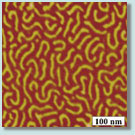| |
 |
 |
 |
|
 |
 |
 |
 |
 |

|
 |
 |
|
|
|
 |
A
Ferrous Wheel in the Forest; Scientists
develop new hypothesis on the fate of
acid rain |
 |
| |
 A
new hypothesis is being presented by scientists
from The Woods Hole Research Center, the
University of Arizona, and the University
of Maine that may help explain how acid
rain reacts chemically in forest soils.
"Acids of nitrogen and sulfur in rainwater,
often called 'acid rain,' can have both
positive and negative effects on the health
of forests, streams, and lakes," explained
Eric Davidson of The Woods Hole Research
Center, lead scientist of the study. "Acid
rain is caused by air pollution, such
as emissions from cars and industrial
smoke stacks. It is known to cause nutrient
imbalances in soil and in water that are
harmful to trees, fish, and other plants
and animals." The nitrogen in acid rain
could also, potentially, act as a fertilizer,
thus enhancing the growth of forest trees.
However, most of the nitrogen that falls
on forests as acid rain tends to remain
in the soil rather than being taken up
by the trees. A
new hypothesis is being presented by scientists
from The Woods Hole Research Center, the
University of Arizona, and the University
of Maine that may help explain how acid
rain reacts chemically in forest soils.
"Acids of nitrogen and sulfur in rainwater,
often called 'acid rain,' can have both
positive and negative effects on the health
of forests, streams, and lakes," explained
Eric Davidson of The Woods Hole Research
Center, lead scientist of the study. "Acid
rain is caused by air pollution, such
as emissions from cars and industrial
smoke stacks. It is known to cause nutrient
imbalances in soil and in water that are
harmful to trees, fish, and other plants
and animals." The nitrogen in acid rain
could also, potentially, act as a fertilizer,
thus enhancing the growth of forest trees.
However, most of the nitrogen that falls
on forests as acid rain tends to remain
in the soil rather than being taken up
by the trees.
Photo courtesy: U.S. Department of Agriculture
Read
the full story. ... posted
1/31/03
|
 |
NSF
Director Rita Colwell Delivers Chafee
Memorial Lecture; Archive of Lecture Webcast
Will Be Available Soon |
 |
| |
 National
Science Foundation Director Rita Colwell's
presentation of the third John H. Chafee
Memorial Lecture on Science and the Environment
was webcast from the 3rd National Conference
on Science, Policy, and the Environment
on Thursday, January 30th, at 5:30 p.m.
In her talk, entitled "Obstinate Issues,
Sophisticated Solutions: Environmental
Science and Education for a New Age,"
she spoke of a new age of scientific exploration,
one that will give us a deeper understanding
of our planet and allow us to improve
the quality of people's lives worldwide.
The archive of the lecture webcast will
be available soon. National
Science Foundation Director Rita Colwell's
presentation of the third John H. Chafee
Memorial Lecture on Science and the Environment
was webcast from the 3rd National Conference
on Science, Policy, and the Environment
on Thursday, January 30th, at 5:30 p.m.
In her talk, entitled "Obstinate Issues,
Sophisticated Solutions: Environmental
Science and Education for a New Age,"
she spoke of a new age of scientific exploration,
one that will give us a deeper understanding
of our planet and allow us to improve
the quality of people's lives worldwide.
The archive of the lecture webcast will
be available soon.
Read
the full story/webcast link. ... posted
1/30/03
|
 |
Earth
Scientists Forge New Understanding of
Mountain-Building Dynamics |
 |
| |
 From
volcanic eruptions to earthquakes to catastrophic
mudslides, the geologic processes active
in mountain belts affect human societies
every day. Yet, even though mountains
are on all continents and in all ocean
basins, scientists still understand relatively
little about the forces that interact
to form and destroy mountains, how mountains
change over time, and the relationship
between mountains and Earth's climate.
To better understand these dynamics, earth
scientists are now integrating studies
across traditional disciplinary boundaries.
In research funded by NSF and published
in the January 2003 GSA Today,
scientists have demonstrated a new way
to integrate results from observations
collected in the field with laboratory
and experimental techniques. The team
studied a mountain belt located in Fiordland,
South Island, New Zealand. From
volcanic eruptions to earthquakes to catastrophic
mudslides, the geologic processes active
in mountain belts affect human societies
every day. Yet, even though mountains
are on all continents and in all ocean
basins, scientists still understand relatively
little about the forces that interact
to form and destroy mountains, how mountains
change over time, and the relationship
between mountains and Earth's climate.
To better understand these dynamics, earth
scientists are now integrating studies
across traditional disciplinary boundaries.
In research funded by NSF and published
in the January 2003 GSA Today,
scientists have demonstrated a new way
to integrate results from observations
collected in the field with laboratory
and experimental techniques. The team
studied a mountain belt located in Fiordland,
South Island, New Zealand.
Photo: Keith Klepeis, University of Vermont;
NSF
Read
the full story. ... posted
1/24/03
|
 |
Multiple
Factors Affect Flight Power Curves Among
Species |
 |
| |
 Researchers
using three-dimensional computer modeling
and wind tunnels have made the first accurate
comparative measurements of muscle power
output of birds in-flight to establish
that physical structure, body mass, force
and flight style all have major effects
upon the magnitude and shape of a species'
power curve. The research by Harvard integrative
physiologist Andrew A. Biewener and fellow
researchers was publicly funded through
the National Science Foundation and published
in the Jan. 23 edition of Nature. Researchers
using three-dimensional computer modeling
and wind tunnels have made the first accurate
comparative measurements of muscle power
output of birds in-flight to establish
that physical structure, body mass, force
and flight style all have major effects
upon the magnitude and shape of a species'
power curve. The research by Harvard integrative
physiologist Andrew A. Biewener and fellow
researchers was publicly funded through
the National Science Foundation and published
in the Jan. 23 edition of Nature.
Photo courtesy: ornithopter.org
Read
the full story. ... posted
1/22/03
|
 |
Scientists
Find Geochemical Fingerprint of World
Trade Center Collapse Recorded in New
York Harbor Sediments |
 |
| |
 Dust
and debris deposits associated with the
September 11, 2001, terrorist attack on
the World Trade Center have left a distinct
fingerprint on the sedimentary record
in New York Harbor, scientists have found.
Their results appear in the January 21,
2003, issue of the journal EOS,
a publication of the American Geophysical
Union. This geochemical fingerprint, the
researchers believe, may facilitate a
better understanding of the short-to-medium
term processes that affect the input,
dispersal, and fate of particles and contaminants
in the lower Hudson River. Dust
and debris deposits associated with the
September 11, 2001, terrorist attack on
the World Trade Center have left a distinct
fingerprint on the sedimentary record
in New York Harbor, scientists have found.
Their results appear in the January 21,
2003, issue of the journal EOS,
a publication of the American Geophysical
Union. This geochemical fingerprint, the
researchers believe, may facilitate a
better understanding of the short-to-medium
term processes that affect the input,
dispersal, and fate of particles and contaminants
in the lower Hudson River.
Image: Andrea Booher/FEMA News Photo
Read
the full story. ... posted
1/22/03
|
 |
Helicopter
Crashes in Antarctica; Injured Pilot,
Passenger Flown to New Zealand for Medical
Treatment |
 |
| |
 A
helicopter flying in support of the National
Science Foundation's (NSF) Antarctic research
program has crashed near McMurdo Station,
NSF's science and logistics hub on the
continent. The helicopter's pilot and
a passenger, the only people aboard the
aircraft, were injured in the incident,
which happened at approximately 10:00
p.m. EST on Jan. 16. They were evacuated
to New Zealand aboard a New York Air National
Guard LC-130 cargo aircraft for medical
treatment. Medical personnel accompanied
the injured on that flight. The aircraft
arrived in New Zealand at approximately
noon EST Jan. 17, and the patients were
transferred to a local hospital in Christchurch,
NZ. A
helicopter flying in support of the National
Science Foundation's (NSF) Antarctic research
program has crashed near McMurdo Station,
NSF's science and logistics hub on the
continent. The helicopter's pilot and
a passenger, the only people aboard the
aircraft, were injured in the incident,
which happened at approximately 10:00
p.m. EST on Jan. 16. They were evacuated
to New Zealand aboard a New York Air National
Guard LC-130 cargo aircraft for medical
treatment. Medical personnel accompanied
the injured on that flight. The aircraft
arrived in New Zealand at approximately
noon EST Jan. 17, and the patients were
transferred to a local hospital in Christchurch,
NZ.
Image: NSF
Read
the full story . ... posted
1/17/03
|
 |
New
Study Suggests Missing Link that Explains
How Dinosaurs Learned to Fly |
 |
| |
 Two-legged
dinosaurs may have used their forelimbs
as wing-like structures to propel themselves
rapidly up steep inclines long before
they took to the skies, reports a University
of Montana researcher in the January 17
issue of the journal Science.
The new theory adds a middle step that
may link two current and opposing explanations
for how reptiles evolved into flying birds.
According to Kenneth Dial, author of the
report, the transition from ground travel
to flight may have required a "ramp-up"
phase in which rapid movement of the animal's
front appendages actually forced its body
downward to gain more foot traction as
it made its way up increasingly vertical
slopes. Two-legged
dinosaurs may have used their forelimbs
as wing-like structures to propel themselves
rapidly up steep inclines long before
they took to the skies, reports a University
of Montana researcher in the January 17
issue of the journal Science.
The new theory adds a middle step that
may link two current and opposing explanations
for how reptiles evolved into flying birds.
According to Kenneth Dial, author of the
report, the transition from ground travel
to flight may have required a "ramp-up"
phase in which rapid movement of the animal's
front appendages actually forced its body
downward to gain more foot traction as
it made its way up increasingly vertical
slopes.
Image credit: K.P. Dial, University of
Montana
Read
the full story . ... posted
1/16/03
|
 |
NSF
Workshop Highlights Future of Organic
Electronics and Photonics |
 |
| |
 Organic
electronics and photonics -- the field
of research that yielded LEDs -- now shows
promise for wearable computers and artificial
nerves. No longer the target of solely
experimental research, electronic and
photonic components crafted from organic
chemicals now drive major markets. Organic
electronics and photonics applications
in development may have a broader impact,
serving as flexible electronics, biologically
compatible devices, solid-state lighting,
chemical sensors and devices yet to be
conceived. At a workshop sponsored by
the National Science Foundation, experts
from both industry and universities will
discuss the future of this field. Organic
electronics and photonics -- the field
of research that yielded LEDs -- now shows
promise for wearable computers and artificial
nerves. No longer the target of solely
experimental research, electronic and
photonic components crafted from organic
chemicals now drive major markets. Organic
electronics and photonics applications
in development may have a broader impact,
serving as flexible electronics, biologically
compatible devices, solid-state lighting,
chemical sensors and devices yet to be
conceived. At a workshop sponsored by
the National Science Foundation, experts
from both industry and universities will
discuss the future of this field.
Image credit: Dan Schwartz, D.I.S.C.;
Benjamin J. Schwartz and Sarah Tolbert,
UCLA; NSF
Read
the full story . ... posted
1/15/03
|
 |
Researchers
Tie Worldwide Biodiversity Threats to
Growth in Households; Pandas in China
face encroachment, as do other species
in global "hotspots" |
 |
| |
 Scientists
from Michigan State (MSU) and Stanford
universities, in a fresh look at world
population dynamics, have revealed evidence
that increased numbers of households,
even where populations are declining,
are having a vast impact on the world's
biodiversity and environment. Reduction
in household size has led to a rapid rise
in household numbers around the world
and has posed serious challenges to biodiversity
conservation, write Jianguo (Jack) Liu
of MSU and Stanford colleagues Gretchen
C. Daily, Paul R. Ehrlich and Gary W.
Luck in the Jan. 12 advance online publication
of the journal Nature. "Personal
freedom and social choice may come at
a huge environmental cost," says Liu,
lead author for the Nature article.
Liu studied the loss of panda habitat
in China under a Faculty Early Career
Development (CAREER) grant from the National
Science Foundation. Scientists
from Michigan State (MSU) and Stanford
universities, in a fresh look at world
population dynamics, have revealed evidence
that increased numbers of households,
even where populations are declining,
are having a vast impact on the world's
biodiversity and environment. Reduction
in household size has led to a rapid rise
in household numbers around the world
and has posed serious challenges to biodiversity
conservation, write Jianguo (Jack) Liu
of MSU and Stanford colleagues Gretchen
C. Daily, Paul R. Ehrlich and Gary W.
Luck in the Jan. 12 advance online publication
of the journal Nature. "Personal
freedom and social choice may come at
a huge environmental cost," says Liu,
lead author for the Nature article.
Liu studied the loss of panda habitat
in China under a Faculty Early Career
Development (CAREER) grant from the National
Science Foundation.
Photo credit: Sue Nichols, Michigan State
University
Read
the full story. ... posted
1/13/03
|
 |
Scientists
Find First Active 'Jumping Genes' in Rice |
 |
| |
 University
of Georgia researchers studying rice genomes
under a National Science Foundation Plant
Genome Research Program award have identified
the species' first active DNA transposons,
or "jumping genes." The research is published
in the Jan. 9 edition of the journal Nature.
In collaboration with researchers from
Cornell, Washington University and Japan,
geneticist Susan Wessler also discovered
the first active "miniature inverted-repeat
transposable element," or "MITE," of any
organism. The discovery of active transposons
in rice provides startling new insights
into how genomes change and what role
transposons may play in the process. Active
DNA transposons can move new copies of
DNA to different places in the genome. University
of Georgia researchers studying rice genomes
under a National Science Foundation Plant
Genome Research Program award have identified
the species' first active DNA transposons,
or "jumping genes." The research is published
in the Jan. 9 edition of the journal Nature.
In collaboration with researchers from
Cornell, Washington University and Japan,
geneticist Susan Wessler also discovered
the first active "miniature inverted-repeat
transposable element," or "MITE," of any
organism. The discovery of active transposons
in rice provides startling new insights
into how genomes change and what role
transposons may play in the process. Active
DNA transposons can move new copies of
DNA to different places in the genome.
Image credit: USDA
Read
the full story . ... posted
1/8/03
|
 |
Wireless
Network Boosts Supernova Search to Stellar
First Year |
 |
| |
 In
results presented this week at the 2003
meeting of the American Astronomical Society
in Seattle, astrophysicist Greg Aldering
and colleagues report that their supernova
factory project has discovered an unprecedented
34 new supernovae in its first year. The
accomplishment would not have been possible
without the NSF-supported high-performance
wireless network link to Palomar Observatory.
"This has been the best rookie year for
any supernova search project," Aldering
said. In
results presented this week at the 2003
meeting of the American Astronomical Society
in Seattle, astrophysicist Greg Aldering
and colleagues report that their supernova
factory project has discovered an unprecedented
34 new supernovae in its first year. The
accomplishment would not have been possible
without the NSF-supported high-performance
wireless network link to Palomar Observatory.
"This has been the best rookie year for
any supernova search project," Aldering
said.
Image credit: High Performance Wireless
Research and Education Network (HPWREN)
Read
the full story . ... posted
1/7/03
|
 |
Genomes, Cosmos, and Nano Among NSF Science Highlights from 2002
|
 |
| |
 Looking back on 2002, research supported by the National Science Foundation continued to make headlines and expand the horizons of science and education in the United States and around the world. NSF's science success was also recognized in the year's Nobel Prizes -- five of the eight Nobel laureates in physics, chemistry and economics received NSF funding during their careers. Other notable results of NSF support ran the gamut from the completion of the rice genome to the discovery of 3,000-year-old microbes living deep below the ice of Antarctica's Lake Vida. Looking back on 2002, research supported by the National Science Foundation continued to make headlines and expand the horizons of science and education in the United States and around the world. NSF's science success was also recognized in the year's Nobel Prizes -- five of the eight Nobel laureates in physics, chemistry and economics received NSF funding during their careers. Other notable results of NSF support ran the gamut from the completion of the rice genome to the discovery of 3,000-year-old microbes living deep below the ice of Antarctica's Lake Vida.
Image credit: CBI/Caltech/NSF
Read
the full story . ... posted
1/6/03
|
 |
Breakthrough
Brings Laser Light to New Regions of the
Spectrum |
 |
| |
 Combining
concepts from electromagnetic radiation
research and fiber optics, researchers
have created an extreme-ultraviolet, laser-like
beam capable of producing tightly-focused
light in a region of the electromagnetic
spectrum not previously accessible to
scientists. Between 10-100 times shorter
than visible light waves, the extreme-ultraviolet
(EUV) wavelengths will allow researchers
to "see" tiny features and carve miniature
patterns, with applications in such fields
as microscopy, lithography and nanotechnology.
The achievement is based on a new structure
called a "waveguide," a hollow glass tube
with internal humps that coax light waves
into traveling along at the same speed
and help the waves reinforce each other.
A report on the work, which is part of
a continuing project supported by the
National Science Foundation, appears in
the January 2 issue of the journal Nature. Combining
concepts from electromagnetic radiation
research and fiber optics, researchers
have created an extreme-ultraviolet, laser-like
beam capable of producing tightly-focused
light in a region of the electromagnetic
spectrum not previously accessible to
scientists. Between 10-100 times shorter
than visible light waves, the extreme-ultraviolet
(EUV) wavelengths will allow researchers
to "see" tiny features and carve miniature
patterns, with applications in such fields
as microscopy, lithography and nanotechnology.
The achievement is based on a new structure
called a "waveguide," a hollow glass tube
with internal humps that coax light waves
into traveling along at the same speed
and help the waves reinforce each other.
A report on the work, which is part of
a continuing project supported by the
National Science Foundation, appears in
the January 2 issue of the journal Nature.
Image credit: University of Colorado and
NSF
Read
the full story. ... posted
1/2/03
|
 |
Spider
vs. Fly: Specialized Deception, Attack
and Defense Rule the Conflict |
 |
| |
 It
seems quite simple: Spider spins web.
Fly gets caught in web. Spider spins silk
lunch box around fly, feasting on the
treat at a later time. End of story. Not
so, according to scientists studying the
relationship between some spiders and
flies under an NSF research award. It's
more of a full-blown engagement involving
specialized attacks, defenses, and purposeful
deception. Biologist George Uetz and fellow
researchers examined the postures of the
social orb-weaving spider, Metepeira
incrassata, in relation to the sarcophagid
fly, Arachnidomyia lindae (a
specialized predator of Metepeira
spider eggs) and the non-predatory domestic
housefly, Musca domestica. The
study, published in the journal Behavioral
Ecology and Sociobiology, suggests
that a highly specialized predator's attacks
may cause the evolution of predator-specific
defensive responses in the prey. It
seems quite simple: Spider spins web.
Fly gets caught in web. Spider spins silk
lunch box around fly, feasting on the
treat at a later time. End of story. Not
so, according to scientists studying the
relationship between some spiders and
flies under an NSF research award. It's
more of a full-blown engagement involving
specialized attacks, defenses, and purposeful
deception. Biologist George Uetz and fellow
researchers examined the postures of the
social orb-weaving spider, Metepeira
incrassata, in relation to the sarcophagid
fly, Arachnidomyia lindae (a
specialized predator of Metepeira
spider eggs) and the non-predatory domestic
housefly, Musca domestica. The
study, published in the journal Behavioral
Ecology and Sociobiology, suggests
that a highly specialized predator's attacks
may cause the evolution of predator-specific
defensive responses in the prey.
Photo credit: Greg Auner, Wayne State
University
Read
the full story . ... posted
1/2/03
|
 |
Extreme
Micro-Networks Developed for Wireless
Biosensors |
 |
| |
 While
setting up a wireless network in your
house may be mostly a plug-and-play operation,
a wireless network inside the human body
changes the rules a bit. Putting one inside
the human eye is a whole new ball game.
Networking researchers led by Loren Schwiebert
at Wayne State University and Sandeep
Gupta at Arizona State University, together
with teams of sensor and chip designers,
ophthalmologists and neurosurgeons are
developing the first wireless networks
for biomedical sensors. With support from
an NSF Information Technology Research
award, the team is designing full-fledged
networks that operate under extreme conditions,
for decades at a stretch without repair,
using almost no power, and in a biomedically
safe manner -- all while avoiding interference
and outside tampering. While
setting up a wireless network in your
house may be mostly a plug-and-play operation,
a wireless network inside the human body
changes the rules a bit. Putting one inside
the human eye is a whole new ball game.
Networking researchers led by Loren Schwiebert
at Wayne State University and Sandeep
Gupta at Arizona State University, together
with teams of sensor and chip designers,
ophthalmologists and neurosurgeons are
developing the first wireless networks
for biomedical sensors. With support from
an NSF Information Technology Research
award, the team is designing full-fledged
networks that operate under extreme conditions,
for decades at a stretch without repair,
using almost no power, and in a biomedically
safe manner -- all while avoiding interference
and outside tampering.
Photo credit: Greg Auner, Wayne State
University
Read
the full story . ... posted
1/2/03
|
 |
A
Short Brush with Greatness |
 |
| |
 A
brush-shaped molecule found in cartilage
has inspired researchers to develop a
new group of synthetic "molecular brushes."
As nanotechnology progresses, the brushes
may find a range of applications, from
inclusion within tiny nanomechanical devices
to uses in osteoarthritis therapies. New
kinds of molecular brushes are coming
out of the laboratories of Sergei Sheiko
and Michael Rubinstein of the University
of North Carolina at Chapel Hill (UNC)
and Krzysztof Matyjaszewski of Carnegie
Mellon University in Pittsburg, recipients
of one of NSF's Nanoscale Interdisciplinary
Research Team grants. Sheiko presented
initial results of their research at the
Nanoscale Science and Engineering Conference
held at NSF in December 2002. A
brush-shaped molecule found in cartilage
has inspired researchers to develop a
new group of synthetic "molecular brushes."
As nanotechnology progresses, the brushes
may find a range of applications, from
inclusion within tiny nanomechanical devices
to uses in osteoarthritis therapies. New
kinds of molecular brushes are coming
out of the laboratories of Sergei Sheiko
and Michael Rubinstein of the University
of North Carolina at Chapel Hill (UNC)
and Krzysztof Matyjaszewski of Carnegie
Mellon University in Pittsburg, recipients
of one of NSF's Nanoscale Interdisciplinary
Research Team grants. Sheiko presented
initial results of their research at the
Nanoscale Science and Engineering Conference
held at NSF in December 2002.
Image credit: Marcelo da Silva, UNC Chapel
Hill
Read
the full story . ... posted
1/2/03
|
 Top
of Page Top
of Page
|
|
|
 |
 |
 |
 |
 |
 |
 |
 |
|
 |
 |
 |
|
|

